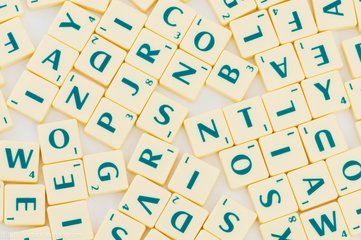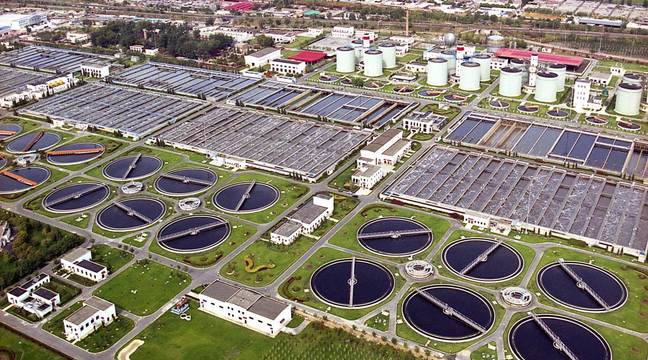
当前课程知识点:Water and Wastewater Treatment Engineering: Biochemical Technology > Chapter 6 Biological nitrogen and phosphorus removal process > Section 6.3 Biological phosphorus removal process and technology > Section 6.3 Biological phosphorus removal process and technology
返回《Water and Wastewater Treatment Engineering: Biochemical Technology》慕课在线视频课程列表
返回《Water and Wastewater Treatment Engineering: Biochemical Technology》慕课在线视频列表
同学们好,下面我们来学习第三节废水生物除磷的工艺与技术
主要有两个内容
第一个是厌氧—好氧生物除磷工艺
第二点是来介绍生物法跟化学法相结合的一种除磷工艺
首先我们来回顾一下生物除磷的基本原理
我们在前边已经介绍过,生物除磷
是由于在活性污泥法中间有一种特殊的细菌
这种细菌我们有时候把它称作除磷菌或者称作聚磷菌
这种细菌的特点是在好氧条件下它可以大量摄取水中的磷酸盐
把它转化成体内的聚合磷酸盐颗粒
在这种情况下,如果我们能够快速的进入沉淀池并且进行沉淀
并且把这种高含磷的污泥进行排放
就可以实现从废水中间去除磷酸盐的目的
但是为了让细菌能够在好氧条件下过量的摄取磷酸盐
我们必须要把污泥回流到前端的厌氧池
在厌氧池中间,由于这种细菌不能够获得足够的能量
所以它会把体内的磷酸盐的颗粒,把它分解释放出来
在释放的过程中间,从废水中间摄取一些小分子的有机物
把它合成一种有机颗粒,我们称为聚β羟基丁酸的的颗粒或者叫PHB的颗粒
有这样的一个厌氧和好氧交替的运行条件下
就可以在活性污泥系统中间培养出大量的除磷菌
从而实现生物除磷
因此,根据这样的一个生物除磷的基本原理
我们就开发出这样一个厌氧好氧的除磷工艺
有时候我们也称为A-O工艺
在这里,我们可以看见原废水,跟回流污泥首先混合进入厌氧池
在这个厌氧池中间,活性污泥中间的除磷菌
实现磷的释放,并且实现对废水中的一些小分子有机物的摄取
随后进入好氧池,在好氧池中间充分的曝气
一些厌氧细菌,会实现对废水中BOD的去除
但是,除磷菌在好氧条件下就会大量的吸收、摄取废水中的磷
而且形成聚合磷菌源的颗粒在细胞体内,作为储存
随后废水进入这个二沉池
进行快速的沉淀,再通过剩余污泥的排放,就实现磷酸盐的去除
大家要注意一下,跟前面我们讲过的生物脱碳的A-O工艺的差别
这样的一个A-O工艺的工艺特点,主要表现在
第一它的水力停留时间一般是在3-6个小时
在曝气池中间的污泥浓度一般在2500-3000 mg/L左右
对废水中间磷的去除效果一般能达到70%左右
出水中磷的含量可以小于1 mg/L
污泥中间的磷的含量可以达到4%
比通常的活性污泥要高一倍到两倍
这样的一个污泥具有一定的肥效
整个系统,由于活性污泥交替的在厌氧和好氧条件下运行
所以整个系统中间活性污泥的SVI值会小于100
比较容易沉淀,不容易发生污泥膨胀
下面,来介绍生物除磷跟化学除磷相结合的一种工艺
我们称为Phostrip的除磷工艺
前面我们看到了生物除磷的工艺,主要是有两个过程
一个是在厌氧条件下释放磷,在好氧条件下要吸收磷
在厌氧条件下释放的磷,又会在好氧条件下需要再次被吸收
这样看起来就有一些浪费
因此的话,有人就开发出这样的一个生物除磷和化学除磷相结合的工艺
我们可以看到,在这个工艺流程中还是有厌氧池和好氧池
在厌氧池中间,仍然会实现除磷菌的磷的释放
但是,在厌氧池和好氧池之间,增加了一个化学除磷的工艺
把厌氧池中间释放出来的磷通过化学法先把它给沉淀去除
出水回到好氧池,而在好氧池中间
除磷菌的摄取的对象只有进水中间的磷
这样的话,减轻了除磷菌摄取进水中的磷的负担
可以达到更好的处理效果
但是这样的一个污泥过程,会产生两股含磷的污泥
一股是生物含磷污泥,一股是化学含磷污泥
这样的一个工艺特点是除磷的效果非常好
处理出水中的含磷量一般可以低于1 mg/L
而污泥中间的含磷量会比较高,一般会到2.1-7.1%之间
在这个过程中间,我们与传统的或者说是完全的化学法相比的话
它的石灰的用量,或者说是铁盐或镁盐的用量会较低
同样这个污泥的SVI也会比较低,污泥非常容易沉淀
而且肥分也比较高,活性污泥不容易发生污泥膨胀
这一节的内容就介绍到这,谢谢
-Section 0.1 Development Status of Wastewater Treatment Process
--Section 0.1 Development Status of Wastewater Treatment Process
-Section 0.2 Typical Processes of Wastewater Biological Treatment
--Section 0.2 Typical Processes of Wastewater Biological Treatment
-Section 1.1 Principles of wastewater aerobic biological treatment
--1.1 Principles of wastewater aerobic biological treatment
-Section 1.2 Principles and determination of wastewater biodegradability
--1.2 Principles and determination of wastewater biodegradability
-Section 1.3 Principles of wastewater anaerobic biological treatment
--Section 1.3.1 Principles of wastewater anaerobic biological treatment(1)
--Section 1.3.2 Principles of wastewater anaerobic biological treatment(2)
-Section 1.4 Principles of wastewater biological nitrogen removal
--Section 1.4 Principles of wastewater biological nitrogen removal
-Section 1.5 Principles of wastewater biological phosphorus removal
--Section 1.5 Principles of wastewater biological phosphorus removal
-Chapter 1 Homework
-Section 2.1 Basic concept of activated sludge process
--Section 2.1.1 Basic concept of activated sludge process
--Section 2.1.2 Basic concept of activated sludge process
-Section 2.2 Growth rule of activated sludge and its application
--Section 2.2 Growth rule of activated sludge and its application
-Section 2.3 Running mode of activated sludge process
--Section 2.3.1 Running mode of activated sludge process(1)
--Section 2.3.2 Running mode of activated sludge process(2)
-Section 2.4 Kinetics of active sludge process
--Section 2.4.1 Kinetics of active sludge process(1)
--Section 2.4.2 Kinetics of active sludge process(2)
--Section 2.4.3 Kinetics of active sludge process(3)
--Research and Development of Kinetic Model of Activated Sludge Process
-Section 2.5 Principle, calculation and equipment of aeration
--Section 2.5.1 Principle, calculation and equipment of aeration(1)
--Section 2.5.2 Principle, calculation and equipment of aeration(2)
-Section 2.6 Designing of activated sludge process
--Section 2.6 Designing of activated sludge process
-Section 2.7 Operation and management of active sludge process
--Section 2.7.1 Operation and management of active sludge process (1)
--Section 2.7.2 Operation and management of active sludge process (2)
-Chapter 2 Homework
-Section 3.1 Basic principle of biofilm
--Section 3.1 Basic principle of biofilm
-Section 3.2 Biofilter process
--Section 3.2.1 Biofilter Process (1)
--Section 3.2.2 Biofilter process (2)
--Section 3.2.3 Biofilter process (3)
-Section 3.3 Biodisk process
-Section 3.4 Biological contact oxidation process
--Section 3.4 Biological contact oxidation process
-Section 3.5 Aerobic biological fluidized bed process
--Section 3.5 Aerobic biological fluidized bed process
-Chapter 3 Homework
-Section 4.1 Oxidation ditch process
--Section 4.1 Oxidation ditch process
-Section 4.2 A-B process
-Section 4.3 SBR process
-Section 4.4 MBR process
-Chapter 4 Homework
-Section 5.1 Overview and characteristics of development of anaerobic biological treatment
--Section 5.1 Overview and characteristics of development of anaerobic biological treatment
-Section 5.2 Anaerobic digester
--Section 5.2 Anaerobic digester
-Section 5.3 Anaerobic contact process and anaerobic filter process
--Section 5.3 Anaerobic contact process and anaerobic filter process
-Section 5.4 UASB process
-Section 5.5 Other anaerobic biological treatment process
--Section 5.5 Other anaerobic biological treatment process
-Section 5.6 Operation management of anaerobic biological treatment process
--Section 5.6 Operation management of anaerobic biological treatment process
-Chapter 5 Homework
-Section 6.1 Introduction
-Section 6.2 Biological nitrogen removal process and technology
--Section 6.2 Biological nitrogen removal process and technology
-Section 6.3 Biological phosphorus removal process and technology
--Section 6.3 Biological phosphorus removal process and technology
-Section 6.4 Simultaneous nitrogen and phosphorus removal process
--Section 6.4 Simultaneous nitrogen and phosphorus removal process
-Chapter 6 Homework
-Section 7 Natural biological treatment process
--Section 7 Natural biological treatment process
-Chapter 7 Homework
-Section 8.1 Source, nature and treatment of sludge
--Section 8.1 Source, nature and treatment of sludge
-Section 8.2 Sludge thickening and digestive stability
--Section 8.2 Sludge thickening and digestive stability
-Section 8.3 Sludge conditioning, dehydration and incineration
--Section 8.3 Sludge conditioning, dehydration and incineration
-Chapter 8 Homework
-Section 9 Wastewater Discharge and Reuse
--Section 9 Wastewater Discharge and Reuse
-Chapter 9 Homework


